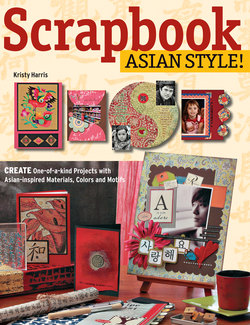Читать книгу Scrapbook Asian Style! - Kristy Harris - Страница 7
На сайте Литреса книга снята с продажи.
ОглавлениеCompositional Yin and Yang
Using Symmetry and Asymmetry in Your Projects
Balance from the Chinese perspective can best be described by the principle of yin and yang. Every positive has a negative, every dark spot has light and hard is countered by soft. The Chinese believe deeply in a sense of balance, which is manifested in the concept of something being two-sided or paired. Examples of the Chinese sense of balance can be seen in the use of the “Double Happiness” characters—such as the mandarin duck pairs used as a wedding decoration, the dragon and the phoenix that balance each other and of course the simple yin and yang symbol. Chinese balance is the equal treatment of the dual sides of nature. Symmetrical balance is attained in projects where two (or more) objects having equal weight are used together. It’s easy to achieve symmetry with pairs, an even number of columns and mirrored images. For example, two-page layouts can be symmetrically balanced if the page designs are mirror images of each other.
The Japanese, however, tend to think of design asymmetrically. Asymmetry is the practice of setting off one large image by several smaller ones. Japanese artists believe that asymmetry represents life and that the flowing energy of a subject is expressed in its asymmetry. Design rules in Japanese arts such as ikebana hold that a symmetrically balanced layout is stagnant and represents stillness or death. Japanese asymmetrical balance, or more correctly imbalance, can be done with colors, shapes and position.
Mulege by Kristy Harris
Using the layout and organization of a tatami room as its inspiration, this layout gives a lesson in both asymmetry and symmetry. (Tatami mats are traditional Japanese flooring made from woven straw.) Traditional Japanese homes have a specific room filled with these mats, always in specific configurations and often in groups of three. Each page, when viewed individually, is asymmetrically composed. Yet when combined as a two-page spread, the photographs balance one another symmetrically as they are the same weight and size. In effect, they are mirror images of one another, which creates a symmetrically, balanced layout when viewed as a whole.
Supply Credits Cardstock: Bazzill; Patterned paper: Urban Lily; Rub-ons: Urban Lily; Chipboard embellishments: Scenic Route; Journaling spot: Jenni Bowlin Studio; Chipboard letters: Junkitz; Acrylic paint: Making Memories
Source It!
Asian architecture can be a great source of inspiration for your projects, especially when making compositional choices in your layouts. A search through your local library will yield a number of inspirational books that are filed with images of homes, buildings and plans for Asian design.
Using different colors symbolic of different Asian cultures, these projects highlight the beautiful colors of Asia. Projects are by Wendy Steward, Brenda Marks, Heather Taylor and Odile Germaneau.
